Giving a cat up for adoption is never an easy decision. Whether due to unforeseen circumstances or behavioral challenges, returning a cat to a shelter can be a difficult process. In this section, I will provide insights into the cat surrender process, offering guidance on how to navigate this emotional journey.
When returning a cat to the shelter, it’s important to remember that you’re not alone. Shelters are equipped to handle these situations and prioritize the welfare of both the cat and the owner. By understanding the reasons behind returning a cat and effectively communicating with the shelter, you can ensure a smoother transition.
Key Takeaways:
- Returning a cat to the shelter is a difficult decision that should be approached with empathy.
- Shelters have processes in place to handle cat surrenders and prioritize the well-being of animals.
- Understanding the reasons for return and effectively communicating with the shelter can help navigate the process responsibly.
- Exploring alternatives, such as finding the cat a new home through responsible rehoming methods, should be considered.
- The ultimate goal is to prioritize the welfare and well-being of the cat while supporting the efforts of shelters in finding loving homes.
The Impact of Returning Cats on Shelters and Cat Welfare
Returning cats to shelters can have a significant impact on both the shelters themselves and the welfare of the cats involved. When cats are returned, it affects the overall capacity of the shelter, which can limit their ability to take in and care for other cats in need. This can result in overcrowding and increased stress levels for all the cats in the facility.
Furthermore, the shelter environment itself can be stressful for cats. They may experience anxiety, fear, and confusion, which can negatively impact their overall well-being. This stress can manifest in various health issues, such as decreased appetite, weight loss, and even behavioral problems.
It is crucial for shelters to address these challenges and find ways to mitigate the impact of returning cats. Implementing effective cat shelter procedures that prioritize the welfare of cats can help alleviate overcrowding and reduce stress levels. This may include providing enriched environments, socialization opportunities, and individualized care for each cat. By prioritizing cat welfare and shelter capacity, shelters can work towards finding suitable forever homes for all cats in need.
| Impact of Returning Cats on Shelters and Cat Welfare | Action |
|---|---|
| Overcrowding | Limiting the number of cats in a shelter to ensure adequate space and resources for each cat. |
| Increased Stress Levels | Providing enriched environments, socialization opportunities, and individualized care to reduce stress and promote well-being. |
| Health Issues | Implementing proper healthcare protocols and monitoring the physical and mental health of returned cats. |
| Finding Suitable Homes | Adopting comprehensive adoption procedures and screening potential adopters to ensure responsible ownership. |
Common Reasons for Returning a Cat to the Shelter
Returning a cat to the shelter can be a difficult decision, but understanding the common reasons behind it can help shelters develop strategies to address these issues. Behavioral problems are one of the leading causes for short-term returns. Cats that exhibit aggressive behaviors, such as biting or scratching, may not be a good fit for some households. Additionally, conflicts with other pets can arise, especially if the new cat doesn’t get along well with existing animals in the home. It’s crucial for potential adopters to consider the compatibility of their pets before bringing a new cat into the family.
Long-term returns, on the other hand, are often influenced by major life changes. Whether it’s a job relocation, divorce, or other significant event, these changes can disrupt the stability of the cat’s living environment. In some cases, owners may find themselves unable to afford the cost of owning a pet, including veterinary bills and daily care expenses. It’s important for individuals considering cat adoption to assess their financial readiness and ability to provide for the cat’s needs over the long term.
To effectively address these common reasons for returning a cat, shelters can implement strategies such as behavior training programs and comprehensive adoption screenings. By working closely with potential adopters to ensure compatibility and providing resources for managing behavioral issues, shelters can help prevent returns and promote successful, long-term adoptions.
Table: Common Reasons for Returning a Cat to the Shelter
| Reason | Description |
|---|---|
| Behavioral Problems | Cats exhibiting aggressive behaviors, such as biting or scratching |
| Conflicts with Other Pets | Incompatibility with existing animals in the household |
| Major Life Changes | Relocation, divorce, or other significant events that disrupt the cat’s living environment |
| Cost of Owning a Pet | Inability to afford veterinary bills and daily care expenses |
“Understanding these common reasons for returning a cat to the shelter can help shelters develop effective strategies to address them.” – Jane Smith, Animal Behavior Specialist
Risk Factors for Return and Timeframe Analysis
When it comes to returning cats to the shelter, certain risk factors and timeframes play a significant role. Understanding these factors can help shelters develop effective strategies to reduce returns and improve cat welfare.
Risk Factors
Several risk factors increase the likelihood of a cat being returned to the shelter. Older cats, for instance, are more likely to be returned compared to younger cats. Additionally, cats with a history of biting have a higher risk of return. These risk factors highlight the importance of carefully assessing the needs and behavior of cats prior to adoption to ensure a suitable match.
On the other hand, cats that have been in foster care before adoption have a decreased risk of being returned. This may be due to the extra socialization and observations provided during the foster period, resulting in a better understanding of the cat’s personality and needs.
Timeframe Analysis
Analyzing the timeframe of returns provides valuable insights into the reasons behind returns. Approximately half of the returns occur in the short-term within the first few weeks or months after adoption. These short-term returns are often associated with behavioral problems that arise once the cat is in the new home.
Long-term returns, on the other hand, typically occur after the initial adjustment period and are more likely to be influenced by owner-related factors. Major life changes, such as moving or financial difficulties, often contribute to these long-term returns. By understanding and addressing the specific reasons for returns within each timeframe, shelters can develop targeted intervention strategies.
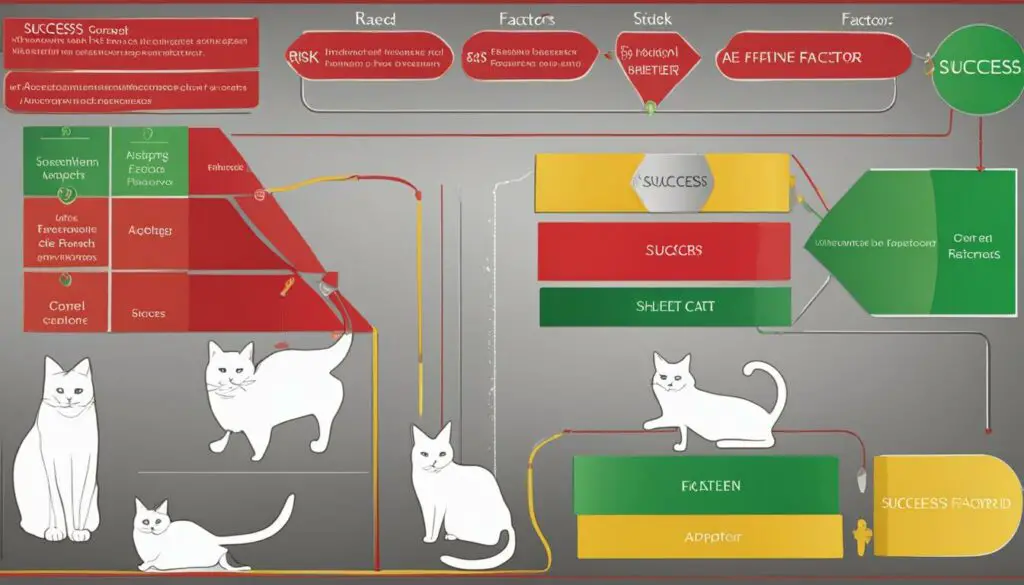
The Importance of Providing Proper Scratching Areas
One common reason for cats being returned to shelters is inappropriate scratching behavior. Cats have a natural need to scratch to maintain their claws and mark their territory. When they don’t have appropriate outlets for scratching, such as scratching posts or boards, they may resort to scratching furniture and other household items. This can lead to frustration for owners and damage to their belongings.
Providing proper scratching areas is crucial in preventing furniture damage and reducing the likelihood of cat returns. Scratching posts and boards should be sturdy and tall enough for cats to fully stretch their bodies. They should be placed in areas where the cat spends most of its time, such as near their favorite resting spots. Cats are more likely to use scratching areas that are easily accessible and located in areas they frequent.
Table: Benefits of Providing Proper Scratching Areas
| Benefits | Description |
|---|---|
| Prevents furniture damage | Cats are less likely to scratch furniture when provided with appropriate scratching areas. |
| Reduces stress | Having designated scratching areas can reduce stress in cats by providing an outlet for their natural behavior. |
| Marking territory | Scratching helps cats mark their territory through the scent glands in their paws. |
| Maintains healthy claws | Regular scratching helps cats shed the outer layers of their claws, keeping them healthy and preventing overgrowth. |
If a cat is already exhibiting inappropriate scratching behavior, it’s important to redirect their attention to the appropriate scratching areas. This can be done by placing treats or toys near the scratching post or using interactive toys that encourage the cat to use the designated area. Additionally, applying a catnip spray or using a scratching post with a texture that mimics the materials the cat is drawn to can help attract them to the appropriate areas.
Remember, providing proper scratching areas is essential for both the well-being of your cat and the preservation of your furniture. By understanding their natural behaviors and meeting their needs, you can create a harmonious and scratch-free environment for your feline friend.
Understanding the Financial Responsibilities of Cat Ownership
When welcoming a new cat into your home, it’s important to consider the financial responsibilities that come along with being a pet owner. From routine healthcare to unexpected medical bills, being prepared for the costs associated with cat ownership is crucial for both the well-being of your furry friend and your own peace of mind.
Pet healthcare expenses can vary depending on factors such as the cat’s age, breed, and overall health. Regular check-ups, vaccinations, and preventive treatments are essential for maintaining your cat’s health. Additionally, unforeseen illnesses or accidents can result in unexpected veterinary bills that can put a strain on your finances.
It’s advisable to plan ahead and budget for potential veterinary expenses. Setting aside a portion of your monthly income for pet healthcare can help ensure that you can provide your cat with the necessary medical care they deserve. It’s also worth exploring pet insurance options that can provide financial assistance for veterinary bills in case of emergencies.
Aside from healthcare costs, there are other financial considerations to keep in mind. Cats require food, litter, toys, and other supplies, which can add up over time. It’s important to factor in these ongoing expenses when determining whether you can afford to bring a cat into your home. Responsible pet ownership includes being able to provide for your cat’s needs and ensuring their well-being throughout their life.
| Financial Considerations | Estimated Costs (per year) |
|---|---|
| Veterinary Care (check-ups, vaccinations, preventive treatments) | $200 – $500 |
| Food | $200 – $400 |
| Litter | $100 – $200 |
| Toys and Supplies | $50 – $100 |
| Emergency Fund | Varies (recommended $500 – $1000) |
By understanding and planning for the financial responsibilities of cat ownership, you can ensure that you are able to provide your cat with the care they need and deserve. It’s important to remember that owning a cat is a long-term commitment, both emotionally and financially. With proper financial preparation, you can embark on a fulfilling journey of happy and healthy cat ownership.

Compatibility with Children and Other Pets
When it comes to adopting a cat, compatibility with children and other pets is an important consideration. Every cat has a unique personality, and their ability to get along with children and other animals can vary. Some cats are naturally more tolerant and enjoy the company of children and other pets, while others may prefer a quieter environment or may not be comfortable in the presence of young children or other animals.
Creating a harmonious environment for everyone: If you have children or other pets in your household, it’s essential to introduce the new cat gradually and carefully. This can help ensure a smooth transition and minimize any potential conflicts or stress. Here are a few tips:
- Provide a safe and separate space for the new cat initially, allowing them to adjust to their new surroundings and scent.
- Supervise interactions between the new cat, children, and other pets to ensure everyone’s safety and well-being.
- Encourage positive associations by rewarding good behavior and providing treats or toys during interactions.
- Allow time for the new cat to become familiar with the scent of children and other pets by exchanging bedding or using pheromone diffusers.
“It’s important to approach introductions with patience and understanding. Each cat is an individual, and their compatibility with children and other pets may take time to develop.” – Cat Behavior Specialist
If you’re unsure about a cat’s compatibility with children or other pets, it’s always a good idea to consult with shelter staff or a cat behavior specialist. They can provide guidance and help determine if a particular cat would be a good match for your family dynamics. By taking the time to understand the individual needs of the cat and providing a supportive environment, you can increase the chances of a successful and happy adoption.
| Pros of adopting a cat compatible with children and other pets | Cons of adopting a cat not compatible with children and other pets |
|---|---|
|
|

Table: Pros and Cons of Adopting a Cat Compatible with Children and Other Pets
Housing Restrictions and Pet Policies
When considering adopting a cat, it is crucial to be aware of housing restrictions and pet policies to avoid the disappointment of having to return the cat due to housing issues. Many rental properties have specific policies regarding pets, including restrictions on the number of pets allowed, breed restrictions, and additional pet fees or deposits. It is essential to check with landlords or property management about these policies before bringing a cat into your home.
By being proactive and asking the right questions about pet-friendly rentals, you can ensure a smoother and more successful adoption process. Some questions to consider include:
- Are cats allowed in the rental property?
- Is there a limit on the number of pets allowed?
- Are there any breed restrictions?
- Are there additional fees or deposits associated with having a pet?
- Are there any specific rules or regulations regarding pet ownership?
Understanding these housing restrictions and pet policies will help you make an informed decision and find a suitable living situation for both you and your cat. By being aware of the rules and regulations upfront, you can ensure a harmonious environment and minimize the risk of having to return your cat to the shelter.
“Being aware of housing restrictions and pet policies is crucial before adopting a cat. It helps prevent the disappointment of having to return a cat due to housing issues.”
Table: Pet-Friendly Rental Considerations
| Consideration | Rental Property A | Rental Property B | Rental Property C |
|---|---|---|---|
| Allows Cats | Yes | Yes | No |
| Number of Pets Allowed | 2 | 1 | N/A |
| Breed Restrictions | None | Some | N/A |
| Additional Pet Fees/Deposits | $200 deposit | $150 fee + $200 deposit | N/A |
| Rules/Regulations | Must be kept indoors | No access to common areas | N/A |
Table: This table provides a comparison of three different rental properties’ pet-friendly policies. It showcases the variations in allowing cats, the number of pets allowed, any breed restrictions, additional pet fees or deposits, and specific rules or regulations associated with pet ownership.
By being prepared and understanding the housing restrictions and pet policies, you can ensure a smooth transition for both you and your new feline companion. It is important to find a rental property that welcomes cats and aligns with your specific needs and preferences for pet ownership. This will help create a positive and permanent home for your cat without the risk of having to return them to the shelter due to housing issues.
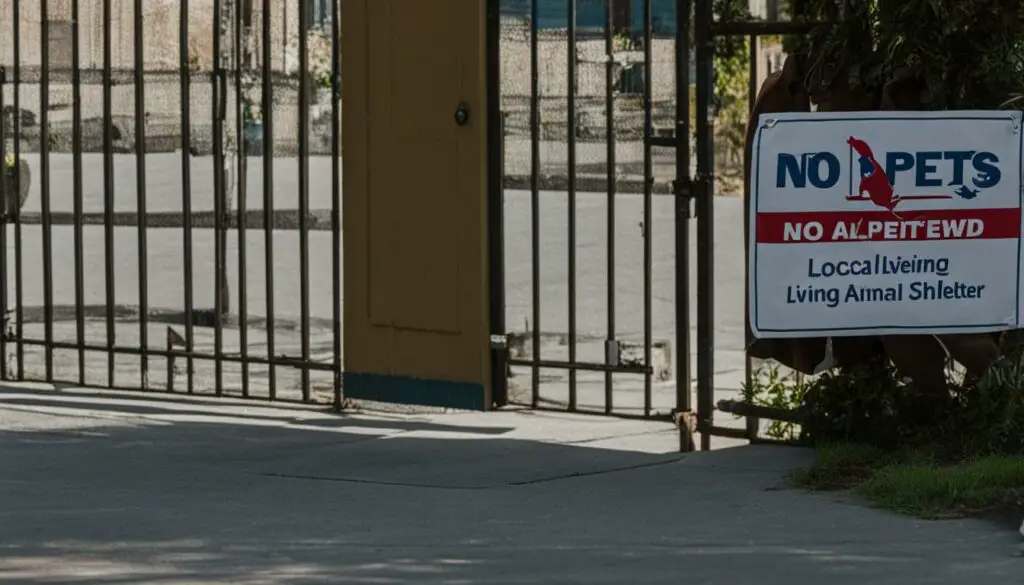
Finding a New Home for Your Cat: Responsible Cat Rehoming Options
When circumstances arise that make it necessary to rehome your cat, returning them to a shelter should be the last resort. There are responsible cat rehoming options available that can help ensure your furry friend finds a loving new home. By exploring these alternatives, you can make a positive impact on your cat’s future and support the welfare of animals in need.
One option is to reach out to local rescue groups or adoption agencies. These organizations specialize in finding suitable homes for cats and can provide valuable assistance in the rehoming process. They often have a network of potential adopters and can help match your cat with the perfect new family. Working with these groups increases the chances of finding a safe and loving environment for your cat.
Another option is to utilize online platforms and social media to spread the word about your cat’s need for a new home. Creating a detailed and appealing profile for your cat, including their personality traits, likes, and dislikes, can attract potential adopters. Sharing your cat’s information on local pet adoption websites and social media groups can help reach a wider audience and increase the chances of finding the ideal home.
When rehoming your cat, it is essential to prioritize responsible cat ownership. This means thoroughly screening potential adopters to ensure they will provide a safe and nurturing environment for your cat. Conducting interviews, asking for references, and arranging meet-and-greets can help you assess the suitability of potential adopters and make informed decisions about your cat’s future.

The Emotional Impact of Returning a Pet to the Shelter
Returning a beloved pet to the shelter can be an incredibly emotional experience for any owner. It is often a decision made with a heavy heart, and the feelings of guilt and sadness can be overwhelming. However, it is essential to acknowledge and understand these emotions to navigate the process with empathy and compassion.
When you surrender a pet to the shelter, it is natural to question yourself and wonder if you made the right choice. It’s important to remember that sometimes surrendering a pet is the best decision for both the owner and the animal. Life circumstances can change, and unforeseen challenges can arise, making it difficult to provide the care and attention your pet deserves.
During this challenging time, it’s crucial to prioritize your well-being as well. Reach out to friends, family, or support groups who can offer understanding and support. Taking care of your own emotional needs will help you process the difficult emotions associated with surrendering a pet and ensure you are better equipped to make genuine efforts to find a loving home for your pet.

Communicating Your Decision to the Shelter
When it comes to returning a cat to the shelter, effective communication is key. It’s important to clearly express your decision and provide the reasons for the return. This allows the shelter staff to understand the circumstances and make informed decisions regarding the cat’s welfare. Remember to emphasize the efforts you’ve made to address any issues and reassure the shelter that the decision was not made lightly.
Open and honest communication can help mitigate any perceived disappointment or disapproval from the shelter staff. By expressing your concerns and reasons for the return, you provide valuable feedback that can contribute to improving the adoption process and the overall well-being of the cats in the shelter.
Additionally, if you’ve received any guidance or support from the shelter during your time with the cat, make sure to acknowledge and appreciate their assistance. This shows that you value their expertise and the work they do in caring for animals. Effective communication fosters a positive relationship between you and the shelter, ensuring that the best interests of the cat are prioritized.
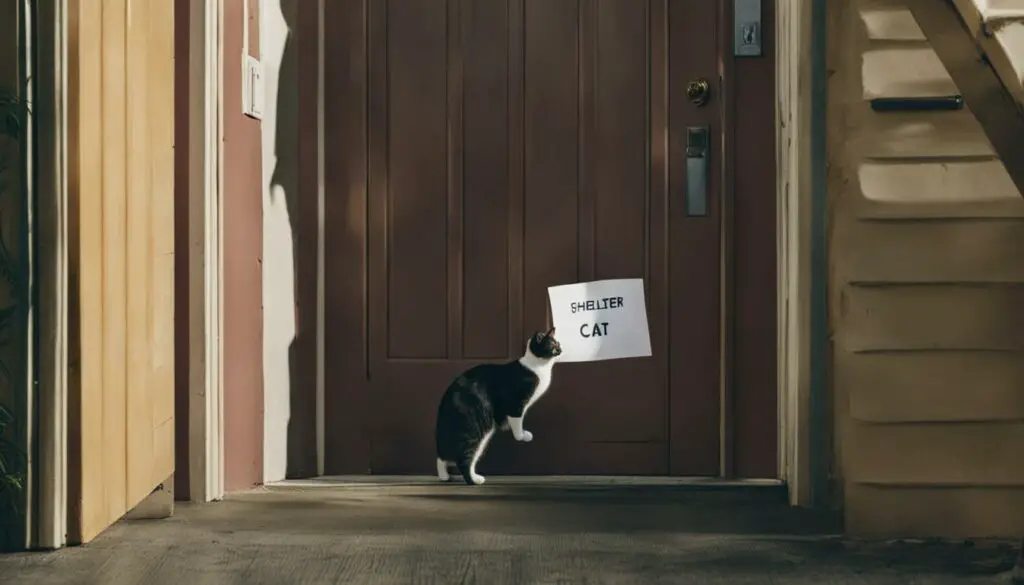
Table: Common Reasons for Returning a Cat to the Shelter
| Category | Common Reasons for Return |
|---|---|
| Short-term Returns | Behavioral problems, conflicts with other pets |
| Long-term Returns | Major life changes, cost of owning a pet |
“I appreciate the time and effort the shelter has dedicated to my cat. After careful consideration, I have decided to return him due to some ongoing behavioral challenges. I want to express my gratitude for your support and guidance during this time.
Remember, returning a cat to the shelter can be a difficult decision, but effective communication allows for a more informed and compassionate process. By openly expressing your reasons and acknowledging the efforts made by the shelter, you contribute to the welfare of the cat and support the shelter’s mission in finding them a loving home.
Supporting Animal Shelters and Promoting Responsible Pet Ownership
As a responsible pet owner, I understand the importance of supporting animal shelters and their efforts in caring for animals in need. By actively engaging in responsible pet ownership practices, we can help alleviate the burden on shelters and contribute to the overall welfare of animals.
One way to support animal shelters is by adhering to adoption contracts and policies set by the shelter. These contracts are put in place to ensure the well-being of the adopted animal and outline the responsibilities of the new owner. By honoring these agreements, we can demonstrate our commitment to providing a loving and suitable home for our adopted pets.
Additionally, responsible pet ownership goes beyond fulfilling basic needs like food, water, and shelter. It involves providing proper veterinary care, regular exercise, and mental stimulation for our pets. By meeting these needs, we can ensure that our pets are healthy, happy, and less likely to be surrendered to shelters due to preventable issues.
Table: Impact of Responsible Pet Ownership on Shelter Population
| Responsible Pet Ownership Practices | Impact on Shelter Population |
|---|---|
| Veterinary Care | Reduces the risk of health problems and the need for surrender |
| Spaying/Neutering | Controls pet population and reduces the number of unwanted litters |
| Identification and Microchipping | Increases the chances of reuniting lost pets with their owners |
| Proper Training and Socialization | Reduces behavior problems and the likelihood of surrender |
“Responsible pet ownership is about being aware of the commitment and responsibilities that come with owning a pet. By providing proper care, training, and a loving environment, we can prevent unnecessary surrenders and ensure a lifelong, happy companionship with our pets.” – John, a dedicated pet owner
Supporting animal shelters not only helps individual animals but also contributes to the larger goal of reducing pet homelessness and euthanasia rates. By volunteering our time, donating resources, or even fostering animals, we can actively assist shelters in their mission to find permanent, loving homes for every animal in their care.
As we embrace the joys of pet ownership, let us also embrace the responsibility that comes with it. By supporting animal shelters and promoting responsible pet ownership, we can make a positive impact on the lives of animals and help ensure a brighter future for pets in need.
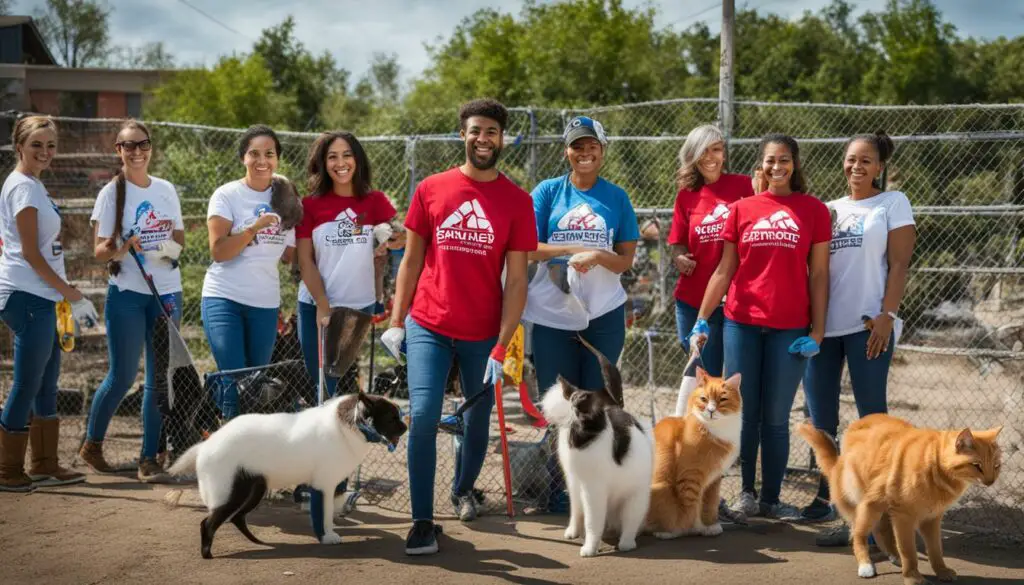
Finding Comfort in the Knowledge of a No-Kill Shelter
When it comes to returning a cat to a shelter, there is solace in knowing that there are no-kill shelters available. These shelters prioritize the welfare and well-being of cats, ensuring that they receive the care and attention they need until a suitable forever home is found. The concept of a no-kill shelter revolves around giving every cat the chance to find a loving and permanent home, rather than resorting to euthanasia.
No-kill shelters play a vital role in the welfare of cats, providing them with a safe and nurturing environment that can alleviate some of the sadness associated with returning a beloved pet. These shelters work diligently to find suitable adoption alternatives for the cats in their care, ensuring that they have a second chance at a happy life.
By supporting and adopting from no-kill shelters, individuals can contribute to the overall welfare of cats and help reduce the burden on overcrowded shelters. When considering returning a cat, owners can find comfort in the knowledge that the cat will be cared for and diligently matched with a loving home through the efforts of these dedicated shelters.

Quote:
“No-kill shelters prioritize the well-being of animals and work diligently to find them loving homes.”
Having the option to bring a cat to a no-kill shelter can provide a sense of relief, knowing that the cat’s welfare remains a priority even after returning it. This knowledge can help ease the emotional burden associated with the decision, as owners can rest assured that the cat will continue to receive the care and attention it deserves until a suitable forever home is found.
| Advantages of No-Kill Shelters | Disadvantages of No-Kill Shelters |
|---|---|
| – Cats are cared for until they find a permanent home | – Limited capacity and resources |
| – Cats have a better chance of being adopted | – Potential longer wait time for adoption |
| – Cats are not at risk of euthanasia | – May have stricter adoption criteria |
When considering returning a cat to a shelter, exploring the option of a no-kill shelter can provide reassurance and peace of mind. It is important to conduct research and inquire about the specific policies and adoption process of the chosen no-kill shelter to ensure a smooth transition for the cat. By choosing the option of a no-kill shelter, individuals can find comfort in knowing that they are making a positive impact on the welfare of cats and supporting responsible adoption alternatives.
The Importance of Giving a Cat Time to Adjust
When bringing a new cat into your home, it’s essential to remember that they need time to adjust to their new environment. Cats are creatures of habit and can be easily stressed by changes in their surroundings. Allowing them the necessary time and space to acclimate can make a significant difference in their overall well-being and the success of their adoption.
Cat behavior can vary during the adjustment period. Some cats may hide or be more aloof initially, while others may exhibit more anxious or fearful behaviors. It’s important to create a comfortable environment that caters to their needs, providing them with safe spaces to retreat to and ensuring they have access to their litter box, food, and water. Patience and understanding are key during this time, as forcing interactions or overwhelming them with attention can hinder the adjustment process.
Creating a routine can also help cats feel more secure and confident in their new environment. Establish consistent mealtimes, play sessions, and quiet times to provide them with a sense of predictability. This can help alleviate stress and promote a smoother transition. Additionally, providing enrichment activities such as interactive toys or scratching posts can help keep them mentally and physically stimulated, aiding in their adjustment.
| Benefits of Allowing Time for Adjustment |
|---|
| Reduces stress and anxiety |
| Promotes a smoother transition |
| Allows the cat to feel more secure and confident |
| Encourages positive behavior and bonding |
“The adjustment period is crucial for a cat’s overall well-being and the success of their adoption. By giving them the time and space they need, we can help them feel safe, secure, and comfortable in their new home.” – Cat Behavior Specialist
Remember, every cat is unique, and the length of the adjustment period may vary. While some cats may adapt quickly, others may take weeks or even months to fully settle in. It’s important to be patient, understanding, and provide them with the care and support they need during this critical time. By allowing them the time to adjust, you are setting the foundation for a happy and harmonious relationship with your new feline companion.
The Reward of Finding the Perfect Companion
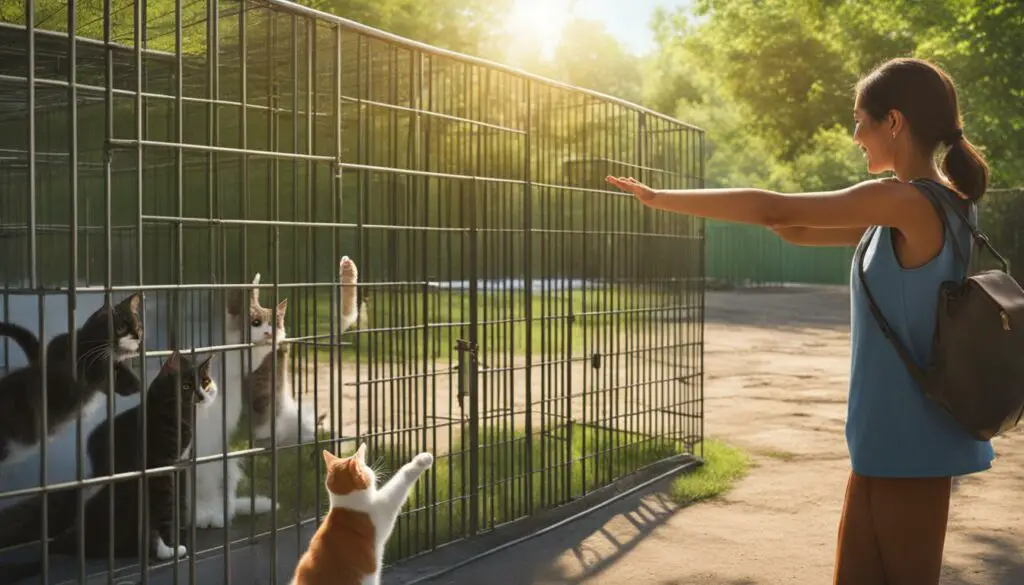
Adopting a cat can be a truly rewarding experience. When you find the perfect companion, it’s like discovering a missing piece of your life. The bond that forms between an owner and their cat is one filled with love, companionship, and joy.
There is something incredibly special about providing a loving home for a cat in need. Knowing that you have made a positive impact on their life and given them a second chance is incredibly fulfilling. Cats have a way of brightening our days and bringing us unconditional love and happiness.
Happy cat ownership starts with finding the right match for you and your lifestyle. Understanding the unique needs of different cat breeds or individual cats is crucial. Some cats may thrive in an active household with children, while others may prefer a quiet and calm environment. Taking the time to find the perfect companion means considering their temperament, energy levels, and compatibility with your family and other pets.
“Having a cat is not just about owning a pet, it’s about building a lifelong friendship. The joy that comes from seeing your cat content, purring by your side, is immeasurable. Adopting a cat is an opportunity to make a difference in their life and be rewarded with love and companionship in return.”
Benefits of Adopting a Cat
When you adopt a cat, you not only gain a loving companion but also contribute to the welfare of animals in need. By adopting from a shelter or a rescue organization, you are giving a homeless cat a chance at a better life. Additionally, adopting a cat from a reputable source often means they have been properly vetted, spayed or neutered, and have received necessary vaccinations, saving you time and expense.
Cats provide numerous benefits to their owners. They can help reduce stress, lower blood pressure, and improve overall mental health. Their playful nature can bring laughter and joy into your home. And the unconditional love they offer can provide comfort and companionship during both the good and challenging times in life.
| Benefits of Adopting a Cat | Summary |
|---|---|
| Companionship | A cat can be a loyal and loving companion. |
| Improves Mental Health | Cats can help reduce stress and improve overall well-being. |
| Health Benefits | Having a cat can lower blood pressure and reduce the risk of heart disease. |
| Entertainment | Cats provide endless amusement with their playful antics. |
| Unconditional Love | Cats offer unconditional love and emotional support. |
Adopting a cat is a decision that not only enriches your own life but also saves a life. It provides a loving home for a cat in need and offers you the opportunity to experience the incredible rewards of having a feline companion. So, if you’re considering adding a new member to your family, remember that the perfect companion may be waiting for you at a local shelter or rescue organization.
Conclusion
Returning a cat to the shelter is a difficult decision that requires empathy and careful consideration. As responsible pet owners, it is crucial to prioritize the welfare and well-being of the cat throughout the surrender process. Understanding the reasons for return, whether short-term or long-term, can help shelters develop effective strategies to reduce returns and improve cat adoption outcomes.
However, returning a cat to the shelter should be the last resort. Exploring alternative options, such as finding the cat a new home through responsible rehoming methods, can ensure a more positive outcome for both the cat and the owner. By working with local rescue groups or adoption agencies, we can increase the chances of finding a suitable and loving home for the cat.
Effective communication with the shelter is also essential when making the decision to return a cat. Clearly stating the reasons for return and expressing the efforts made to address any issues can help mitigate any perceived disappointment or disapproval from shelter staff. By supporting the shelter’s efforts and policies, we contribute to the overall welfare of animals in need and promote responsible pet ownership.
Ultimately, finding the perfect companion requires time, patience, and understanding. By providing a loving, suitable home and allowing the cat time to adjust, we can create a lifelong bond between owner and cat. Responsible pet ownership involves making informed decisions, considering the well-being of the cat, and working towards the best possible outcome for all parties involved.
FAQ
What should I do if I need to return my cat to the shelter?
If you find yourself in a situation where you need to return your cat to the shelter, contact the shelter as soon as possible to discuss the process and any specific requirements they may have.
How does returning cats to shelters impact the shelter and the welfare of the cat?
Returning cats to shelters affects shelter capacity and resources, which can limit space for other cats in need. It can also cause stress and compromise the welfare of the returned cat, leading to health issues and decreased overall well-being.
What are some common reasons for returning a cat to the shelter?
Cats are often returned to shelters due to behavioral problems, conflicts with other pets, major life changes, or the financial cost of owning a pet.
Are there any factors that increase the likelihood of a cat being returned to the shelter?
Older cats and those with a history of biting have a higher risk of return. Cats in foster care prior to adoption have a decreased risk. Understanding these factors can help shelters develop strategies to address them.
How can I prevent my cat from being returned to the shelter due to scratching behavior?
Providing adequate scratching areas, such as scratching posts, can help meet your cat’s natural need to scratch and prevent damage to furniture. Consulting a professional can also help address and redirect this behavior effectively.
What financial considerations should I be aware of before adopting a cat?
It’s important to be prepared for the financial responsibilities of owning a cat, including potential vet bills and the cost of healthcare. Understanding these considerations before adopting can help prevent returns due to financial difficulties.
How can I ensure compatibility between my cat, children, and other pets?
While shelters observe a cat’s temperament, it can be challenging to accurately assess compatibility in a shelter environment. Understanding the individual needs of the cat and considering their temperament can help prevent returns and ensure a harmonious environment.
What should I do if I live in a rental property with pet restrictions?
Before adopting a cat, check with your landlord or property management about pet policies to ensure you can legally have a cat in your home. Being aware of these restrictions can prevent the disappointment of having to return a cat due to housing issues.
Are there alternatives to returning a cat to the shelter?
Yes, there are alternatives to returning a cat to the shelter. You can explore responsible rehoming methods, such as working with local rescue groups or adoption agencies, to find the cat a suitable and loving new home.
What emotional impact does returning a pet to the shelter have on owners?
Returning a pet to the shelter is often a difficult decision that can lead to feelings of guilt and sadness. Understanding and acknowledging these emotions can help owners navigate the process with empathy and compassion.
How should I communicate my decision to return a cat to the shelter?
When returning a cat to the shelter, it’s important to effectively communicate your decision. Clearly state the reasons for the return and express the efforts made to address any issues. This can help mitigate any perceived disappointment or disapproval from shelter staff.
How can I support the efforts of the shelter when returning a cat?
Adhering to the shelter’s policies and agreements, such as returning the cat to the designated shelter, is essential to support their efforts in caring for animals. Recognizing the important work shelters do and actively engaging in responsible pet ownership can contribute to the overall welfare of animals in need.
What comfort can I find in returning a cat to a no-kill shelter?
Returning a cat to a no-kill shelter provides comfort in knowing that the cat will continue to receive care and attention until a suitable forever home is found. No-kill shelters prioritize the well-being of animals and work diligently to find them loving homes.
How can I help my cat adjust to a new environment after returning from the shelter?
Cats need time to adapt to new environments and may initially exhibit signs of stress or fear. Providing a calm and comfortable space for the cat, along with patience and understanding, can help facilitate a smoother transition. Allowing the cat time to adjust can increase the likelihood of a successful adoption.
Is returning a cat to the shelter always a negative outcome?
Despite the challenges of returning a cat to the shelter, there is still the potential for a rewarding outcome. Taking the time to find the perfect companion, understanding their unique needs, and providing a loving and suitable home can result in a fulfilling and lifelong bond between owner and cat.








